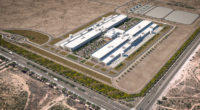Gulfstream Aerospace Corp. plans to construct a sustainable 225,000-sq-ft aircraft service center at the Phoenix-Mesa Gateway Airport in southeast Mesa, Aeiz. The $70-million project represents the largest private investment in the history of the airport, says J. Brian O’Neill, executive director and CEO of the Phoenix-Mesa Gateway Airport Authority.
The facility is the aeronautical company’s first presence in Arizona and will include hangar space, back shops and employee and customer offices, solidifying its regional maintenance, repair and overhaul capabilities, says Derek Zimmerman, customer support president for the Savannah, Ga.-based firm..
Designed by Atlanta-based BRPH Architects, the tilt-up, steel-frame building will also incorporate insulated metal panels.
“The building design is consistent with the modern, operationally efficient approach we are taking with new service center facilities and expansions around the world,” Zimmerman explains. These include locations in Fort Worth; Palm Beach, Fla.; Van Nuys, Calif.; Appleton, Wis; Savannah; and Farnborough, England. General contractor selection is underway.
Gulfstream will begin operating from hangar space in early 2022, with construction following shortly after, although a timeline has not yet been established, he says. The building should open in the second half of 2023.
The project continues the robust economic development activity in Mesa, with Apple, Amazon, Electrameccanica, Dexcom and CMC Steel that have recently built or are building or expanding facilities in the city.
“Mesa, as part of the greater region, has emerged as one of the strongest aerospace and defense hubs in the nation, and our rich history in aviation continues to be a point of pride in our community,” says Mayor John Giles. “Gulfstream’s announcement is the direct result of the city of Mesa’s strategic investment in infrastructure, key economic drivers like the Gateway airport and educational partnerships to meet the labor needs of the many world-renowned corporations.”
Zimmerman notes that hundreds of jobs will be created, most being skilled aircraft technician positions and other support functions. He said he could not quantify the expected construction jobs.
“The local educational institutions, including the aircraft and powerplant (A&P) school at Chandler-Gilbert Community College, Arizona State University and local school districts, are playing a critical role in developing and training the skilled workforce by making sure they offer certificate, degree and training programs that will translate directly to careers at Gulfstream,” Zimmerman says.
In addition to the area’s opportunities for college-trained employees and its size, infrastructure and available land, Gulfstream chose the 3,000-acre site because it is an established business aviation airport, with more than 30 companies operating.
The former Williams Air Force Base, Phoenix-Mesa Gateway is the reliever airport for Sky Harbor International, located 30 miles west, and will serve two million passengers this year, says Ryan Smith, director of communications and government relations for the Airport Authority.
The authotity has 380 acres of aeronautical and nonaeronautical land under development at the $230-million SkyBridge Arizona –– the nation’s first international inland air cargo hub accommodating both Mexican and U.S. customs. “And, we will be moving forward with a master developer in the coming months on about 400 acres of nonaeronautical development on the east side of the airport, where Gulfstream is located,” Smith explains.
“The Gulfstream Mesa facility is part of Gulfstream Customer Support’s strategic plan to modernize and expand its service facilities around the world, and our sustainability goals are playing a leading role in these expansions, and, as a result, these purpose-built facilities are being designed to operate more efficiently and a more environmentally friendly way,” Zimmerman explains.
The LEED Silver-targeted facility will feature a fuel farm with a dedicated sustainable aviation fuel (SAF) supply; low-flow plumbing fixtures; LED lighting; building management systems; and an energy-efficient HVAC system. Designers are also incorporating occupancy sensor-controlled lights, a heat-reflecting white roof, native plants and low-water-demand landscaping, Zimmerman says. “We are also working with the airport authority to explore using green power from the electrical utility and installing solar panels on site,” he adds.





Post a comment to this article
Report Abusive Comment